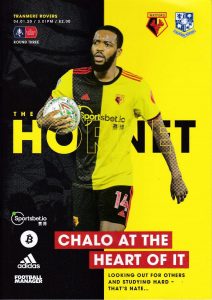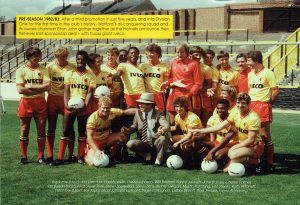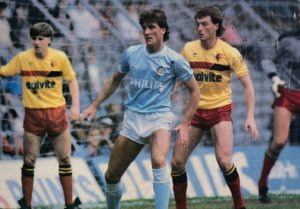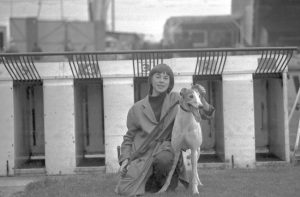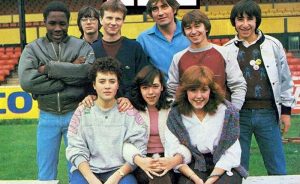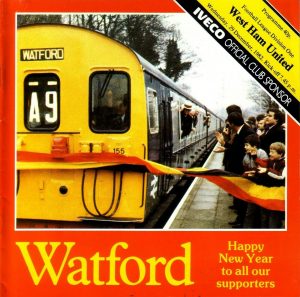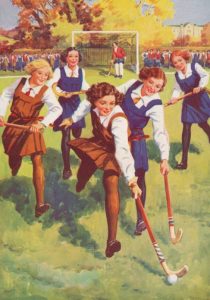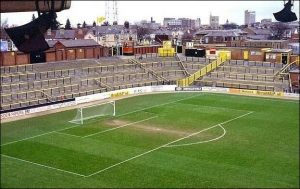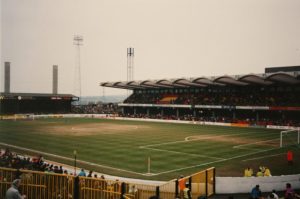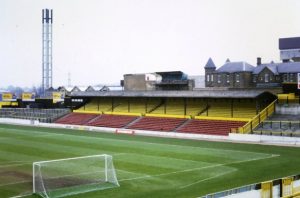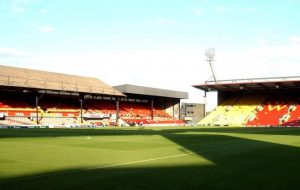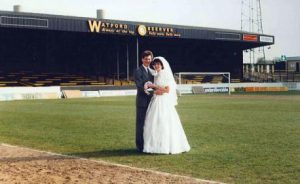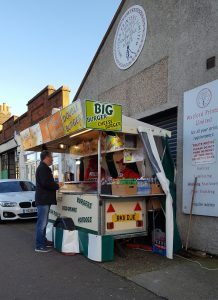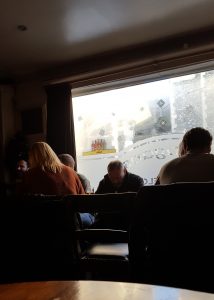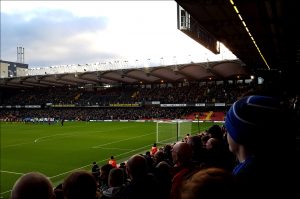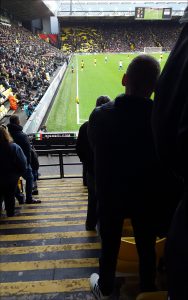Watford 3 Tranmere Rovers 3
FA Cup
Saturday 4 January 2020
The context
John had never been to Vicarage Road but Watford’s Premier League status meant tickets were hard to come by. Alexa – give us a Cup-tie with a plentiful away allocation, let it kick-off at a normal time on an unseasonably warm day and make the opponents my good friends from Birkenhead.
The history
If you plotted Watford’s record on a heatmap the years between 1978 and 1988 would glow bright red. Coincidentally these were my formative years watching football, so my own perception of what has often been an average Home Counties club is hopelessly coloured by their memory. Principally this is of a side dressed too brightly for a drab era, beating teams I liked by irritatingly simple methods. The genius of Graham Taylor was behind both. Red shorts with yellow shirts gave, he thought, an air of invincibility. As for his tactics, “People expected us to play the ball down the middle. When we didn’t they struggled to explain how they lost.”
Fourth Division in 1978 to League runners-up within five years is a remarkable story. So too is an unconventional UEFA Cup campaign featuring a spectacular comeback against the Kaiserslautern of Brehme, Briegel and Allofs. There was also a charismatic run to Wembley in 1984. But I most remember a series of attritional FA Cup matches with Manchester City, mainly because of how bloody cold it was. After a 1-1 draw at Maine Road in January 1986 – Kenny Jackett’s penalty equalising a short-lived lead from Gordon Davies – the replay was delayed a week due to snow, eventually finishing 0-0. The third game took place in Moss Side just three days later and on a bitter Thursday evening Watford proved strongest. They usually did.
Taylor understood context. “The six years we had in the top flight in the 1980s does not mean we are a big club. We spent six years there and 111 outside”, reminds us there’s far more to Watford than just that brief spell (and indeed the present one). Greyhounds, for example. The ground was used for dog racing between 1928 and 1978. Few things cemented a provincial club at the heart of its community back in the day like half a dozen canines chasing a mechanical hare round a dirt track. This wasn’t much fun for the hounds, mind, as the near-right-angled bends on the Vicarage Road track were known as ‘the wall of death’. But it allowed likely lads to enjoy what one fan describes as “sneaking in, setting about the ale and trying to nick a few quid off the woof-woofs.” These things were precious once and vanished now.
Community was at the heart of the ethos built by Taylor and Elton John. Watford players, for instance, were required to live within ten miles of the ground as “I wanted local people to see them shopping etc and for the players to feel the local pulse.” Reaching Wembley was less important to Taylor than the realisation that “I had totally bonded with the locality.” If you believed the media then Vicarage Road suffered less with hooliganism than most, despite its proximity to London (this wasn’t the case but it’s a credit to the club’s efforts that so many bought it). The apotheosis of this PR exercise was ITV’s choice of the ground as filming location for the childrens’ series Murphy’s Mob. The rogueish yet honourable junior supporters of Dunmore United could have been totems for the whole Watford experiment. Even Milton Johns seemed less evil than usual.
Nothing signposts a successful club like a dedicated railway station. This was the case with West Brom in the 30s, Hull in the 50s and Derby in the 90s. The Hornets too got in on the act when Watford Stadium Halt opened at the foot of Occupation Road in 1982. Quickly nicknamed “Hooligan Halt”, the station allowed passengers to be shuttled from Watford Junction to the away turnstiles without setting foot on residential streets. Until the line’s closure a decade or so later many a visiting supporter trudged though the Farm Terrace allotments to reach the ground. This unusual route is remembered fondly by a generation of fans.
There’s more about Watford Stadium Halt here:
Disused Stations: Watford Stadium Station
Notes : On 4 December 1982, a new stop funded by the Football Trust, Watford Football Club and Watford Borough Council, was built on the east side of Vicarage Road to provide support for the increased crowds attending matches at the stadium: Watford had risen from the fourth to the first division under manager Graham Taylor for the first time in the club’s history.
The journey
Third Round day is always an interesting time on the road. Stafford services were busy with Carlisle fans going to Cardiff, and we hadn’t long passed Birmingham before we started to see Merseyside coaches headed the same way as us. In a rare bit of joined-up thinking we checked traffic reports and discovered the M1 was shut, and in yet another we deployed the built-in satnav that came with John’s new car. We did however retain some arlarse credibility by turning the sound off and treating it like a virtual roadmap.
Due to these sensible measures we arrived at Watford Girls’ Grammar School just after one, paid the kind of steep parking charge you’d expect in such refined surroundings and wandered the few hundred yards to the ground. We seemed to have more idea where to find it than some of the Watford fans we came across, despite our not having been for two decades/at all. The explanation lay in cut-price tickets with a vague promise of unspecified priority for upcoming Premiership games – it was creating an unusual dynamic in the home support, but then I guess that’s the magic of the Cup.
The ground
The exterior of Vicarage Road is unimposing. It’s set in a natural bowl with a low street-level frontage. The land drops away on two sides, one of which is inaccessible because it backs onto the local hospital. Buildings at the lower end shield the stands from view. This was the site of the famous allotments but now the whole area has been flattened to make space for new housing and the expanding hospital. The path leading down to the former station survives, although there’s still no news on a long-awaited Metropolitan Line spur which would see the line restored to service.
The ground has two tidy seated ends. These – the Vicarage Road and Rookery stands – look identical, but in fact the Rookery is much bigger. Because of the sloping terrain fans enter the Rookery at the bottom and the Vicarage Road at the top. Both stands went up in the space of a few seasons following the Taylor Report. This redevelopment squared off an elliptical profile dating from the 1920s, and more recently the new Elton John Stand enclosed the Occupation Road side for the first time. The Graham Taylor stand opposite was built on the back of the Eighties boom but not fully seated until some years later.
This stand originally commemorated FA secretary and FIFA president Stanley Rous and was renamed after Taylor in 2014, which on the face of it seems a bit harsh on poor old Sir Stan. It’s an elegant two-tiered piece of work with a vaulted plastic roof that’s more attractive than it sounds. The Rous Stand replaced the much-loved Shrodells, a charming but hopelessly inadequate structure built in the 1930s. Despite being all-seated in its later days this originally had terracing in the front section, at a time when it was possible to walk all the way around Vicarage Road and come back to where you had started. (Shrodells was the Public Assistance Institution, a charitable foundation whose buildings were eventually incorporated into the hospital.)
Elegant is a word that could never describe the Taylor Stand’s chunky, prefabricated counterpart on the opposite side of the pitch. But the Elton John Stand is at least smarter than its predecessors. This touchline once had no fewer than six different sections – the 1922 Main Stand in the centre, an incongruous addition on the Rookery side, two paddock extensions and an area of open seating and terrace towards Vicarage Road. These evolved organically if rather chaotically as the team’s progress outstripped the ground’s seating capacity. They were later closed down sequentially as various safety rulings came into play. The coaching staff used to be isolated here on open benches placed over the disused dog track, Graham Taylor having famously said that until the Vicarage Road terrace was roofed he too would get wet when it rained.
Opinion is divided on the origins of the Rookery name. Some believe that when Watford moved here from Cassio Road the woods leading down to the River Colne (cleared to create the allotments) were a notable haunt of rooks. Others think it refers to slum houses that once stood there. Whatever, unlike the Vicarage Road terrace – which remained uncovered to the end – this section of the ellipse had a cavernous roof which was paid for by the Supporters’ Club in the 1950s. Its notoriously shallow terracing was eventually segregated to hold both home and away fans. As one of the former recalls, “The best thing about the old Rookery was that we stood on concrete terraces under a roof and visiting fans stood outside the roof and on a slag heap. That’s the way to treat visitors.”
Flesh and wine
We’d arrived at the same time as the official coaches so found about 500 Wirralians milling about. Some were taking pictures of their children sitting on a statue of Graham Taylor – it was like Santa’s grotto, if Santa played percentage football. We maintained our unusually responsible behaviour, decided on a food/beer/food strategy and sloped into the nearest chippy to line our stomachs with pie. Vicarage Road is one of those excellent grounds surrounded by cheap and cheerful eating places. In some ways this forces difficult choices, in others it encourages you to go back after the match and raid a burger van you spotted earlier.
It was 20-odd years since the last meeting between these sides and many visiting fans were wondering where to drink. The advice of most locals was to head for the Oddfellows, so we didn’t do that. As the Red Lion on the corner – where I ended up on my previous visit – was all bouncered up and clearly not going to let us in, we settled into the rather less fussy Mangan’s in the relaxed company of sundry local boozers and followers of both clubs. This is one of those Irish pubs that have very few Irish people in them. Despite the press at the bar it was easy to get served – we even found seats in the pool room, underneath a TV showing the Rochdale v Newcastle tie. Happy days.
The game
Demand on Merseyside meant the whole Vicarage Road End had been given over to Tranmere fans. For this reason we had a bit more room to circulate than would normally be the case – something of a blessing, as the exits and concourses at this end must surely be among the tiniest anywhere. We ambled out of the pub and into an old-school awayday complete with cardboard cut-out FA Cups and a general disregard for seat numbering and gangways. The stand is built into the hillside but its concrete steps were flexing like a dancefloor as three thousand people bounced to Tequila.
Watford had entered into the spirit of things by making nine changes and giving debuts to half their youth side. Several looked as though they’d been let out of school for the occasion and one of these, Tom Dele-Bashiru, struck an early opener as nervous Tranmere defenders invited him to pick his spot. Nathaniel Chalobah profited from more hesitancy two minutes later and then Roberto Pereyra notched a fine third as the youngsters ran rings around a pedestrian visiting team. The possibilities for Rovers shrank in front of our eyes from causing an upset to avoiding a thrashing, and the fearful conversation at half time was all about how many Watford might get when legs and hearts tired later on.
Micky Mellon, however, confounded we of little faith and showed himself master of the half-time substitution. His introduction of Woods and Blackett-Taylor stiffened the Tranmere spine and some ill-judged sitting back by Watford did the rest. For once in a way VAR wasn’t a complete pain in the arse, overruling the linesman for Connor Jenning’s perfectly good headed goal and then confirming that Mason Barrett had brought down Blackett-Taylor in the box rather than the other way around. The penalty was preceded by a thumping Rovers second from Manny Monthe. For added spice we had various Watford juveniles going down with cramp and a harsh late dismissal for Pereyra.
Did we like that.
Teams and goals
Watford: Bachmann, Mariappa, Dawson, Spencer-Adams (Barrett 77), Masina, Quina (Whelan 61), Chalobah (Junqueira de Jesus 45), Dele-Bashiru, Success, Gray, Pereyra. Unused subs: Sarr, Dalby, Hungbo, Parkes.
Tranmere: Chapman, Caprice, Clarke, Monthe, Nelson (Woods 45), Morris, Danns, Jennings, Perkins, Ferrier (Mullin 81), Payne (Blackett-Taylor 45). Unused subs: Woods, Ray, Gilmour, Pilling, Walker-Rice.
Goals: Watford: Dele-Bashiru 12, Chalobah 14, Peyeyra 34. Tranmere: Jennings 65, Monthe 78, Mullin 87 (pen).
Attendance: 14,373.


